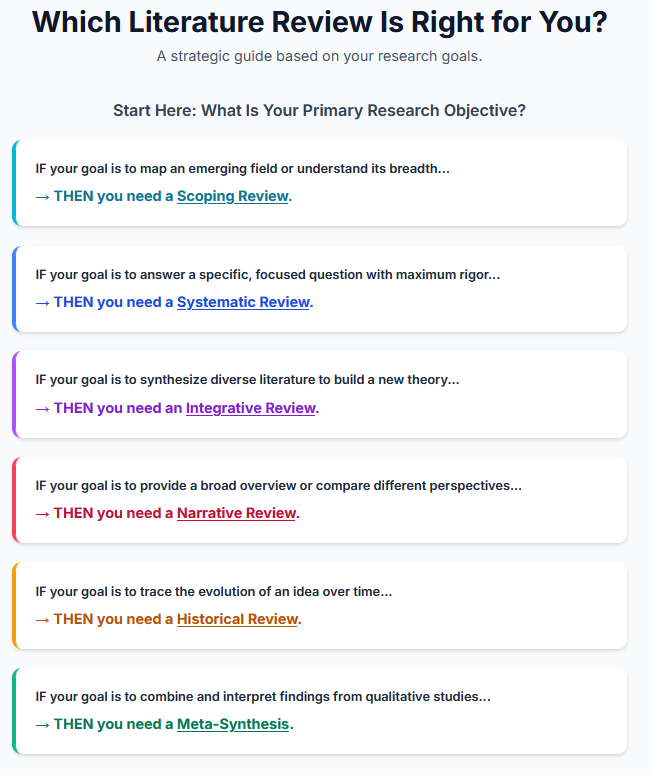In academic research, the term "literature review" is often used as if it were a single, monolithic task. But this couldn't be further from the truth. A literature review is not just a summary of existing knowledge; it is a powerful scholarly tool, and like any tool, you must choose the right one for the job.
Selecting the appropriate type of literature review is one of the most critical strategic decisions you will make. It shapes the scope of your inquiry, defines the rigor of your approach, and ultimately determines the kind of contribution you can make to your field.
This guide will walk you through the six most common types of literature reviews, framed not as a simple list, but as a strategic toolkit for the discerning researcher.
Part 1: Reviews for Mapping the Territory
When you are venturing into a new or complex field, your first task is to understand the landscape. These reviews are your maps.
- 1. The Scoping Review (The Explorer's Map)
A scoping review is designed to map the extent, range, and nature of research activity in an emerging or under-researched area. It doesn’t seek to answer a specific question of effectiveness, but rather to identify the key concepts, evidence types, and gaps in the research landscape.
- Best For: Understanding the breadth of an emerging field or determining if a full systematic review is feasible.
- Example: Exploring how artificial intelligence is being applied across different areas of primary education.
- 2. The Historical Review (The Historian's Timeline)
This type of review traces the evolution of a specific idea, theory, or research topic over time. It helps you understand how the conversation has developed, how key concepts have changed, and how the past has shaped the present understanding of your field.
- Best For: Providing context and perspective on long-standing theories or concepts.
- Example: Tracing the evolution of teaching methodologies from the 20th century to the rise of digital learning.
Part 2: Reviews for Synthesising the Evidence
When the landscape is more established, your goal shifts to synthesising what is already known to provide a clear, evidence-based answer.
- 3. The Systematic Review (The Scientist's Gold Standard)
This is the most rigorous type of review. It follows a strict, predefined, and transparent methodology to collect, appraise, and synthesise all available evidence on a specific, focused question. The goal is to minimise bias and provide a reliable, replicable conclusion.
- Best For: Answering a specific clinical or policy question, such as the effectiveness of a particular intervention.
- Example: Comparing the effectiveness of two different treatments for a specific medical condition by analysing all relevant randomised controlled trials.
- 4. The Integrative Review (The Architect's Blueprint)
More flexible than a systematic review, an integrative review aims to critically analyse and synthesize literature on a topic to generate a new framework or theory. It is unique in its ability to combine diverse methodologies, including theoretical and empirical studies.
- Best For: Building a foundation for a new conceptual model or theory.
- Example: Reviewing studies on workplace productivity from psychology, sociology, and economics to propose a new, holistic model.
Part 3: Reviews for Building New Perspectives
Sometimes, the goal is not just to summarize, but to create a new understanding by interpreting the existing literature in a novel way.
- 5. The Narrative Review (The Storyteller's Synthesis)
A narrative (or traditional) review provides a broad overview of a topic from a particular perspective. It doesn't follow a strict methodological protocol, allowing the author to weave a "story" from the literature that highlights trends, debates, and gaps.
- Best For: Providing a comprehensive introduction to a topic or comparing different schools of thought.
- Example: Analyzing the major trends in climate change policy debates over the last twenty years.
- 6. The Meta-Synthesis (The Philosopher's Integration)
This review focuses exclusively on qualitative research. It doesn't just combine findings; it integrates and interprets them to create a new, higher-level understanding of a phenomenon. It seeks to find the story within the stories.
- Best For: Creating a new interpretation or theory by merging insights from multiple qualitative studies.
- Example: Synthesizing findings from several ethnographic studies to develop a richer understanding of the patient experience in hospitals.
Final Thoughts
Literature reviews are your opportunity to demonstrate your mastery of your field and to position your own research within the broader scholarly conversation. By choosing the right type of review for your specific purpose, you can ensure your work is not only rigorous but also insightful, impactful, and relevant.
Frequently Asked Questions (FAQ)
- What is the most common type of literature review for a PhD thesis?
While it varies by field, many PhD theses incorporate elements of an Integrative Review or a Narrative Review in their early chapters to establish the theoretical framework and identify the research gap. A full Systematic Review can often be a standalone chapter or a separate publication. - How is a Systematic Review different from a Scoping Review?
The key difference is the question. A Systematic Review seeks to answer a very specific, narrow question (e.g., "Is Treatment A better than Treatment B?"). A Scoping Review asks a much broader question (e.g., "What research exists on this topic?"). A scoping review maps the territory; a systematic review drills down into a specific location on that map. - Can I combine different types of reviews?
Yes. It's common for a research project to use different approaches at different stages. For example, you might start with a Scoping Review to understand a new field, which then helps you formulate a specific question for a Systematic Review.


